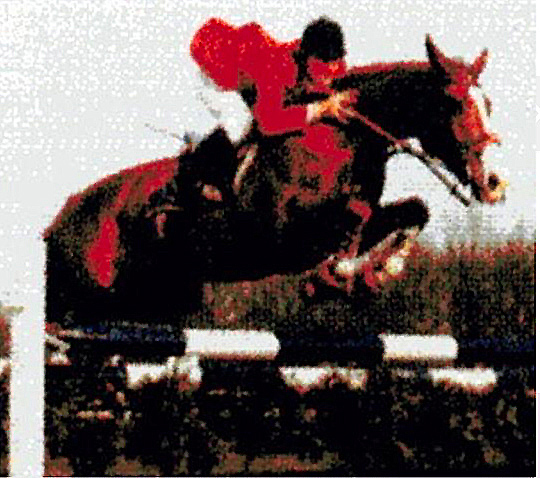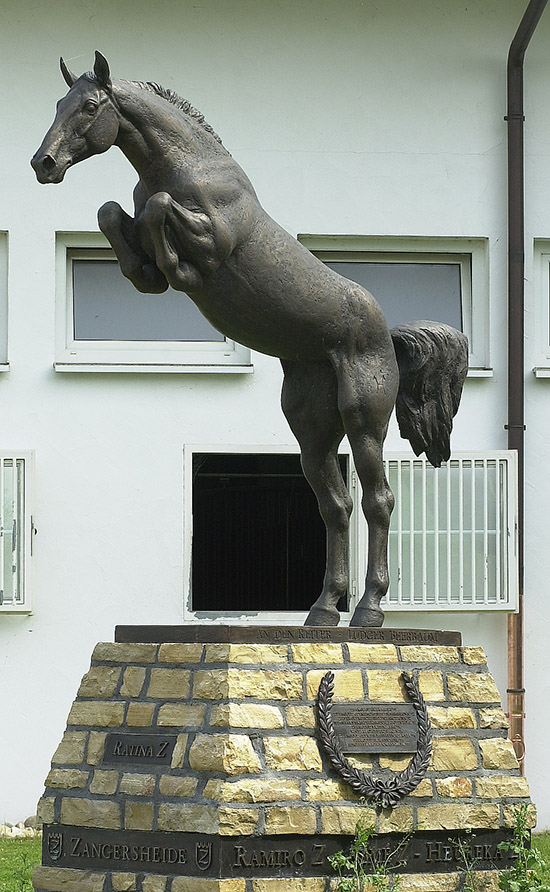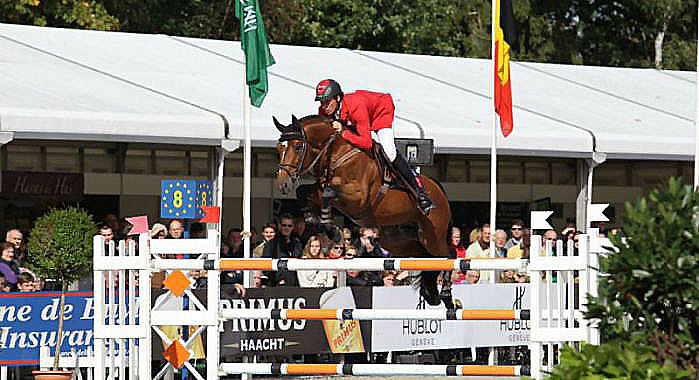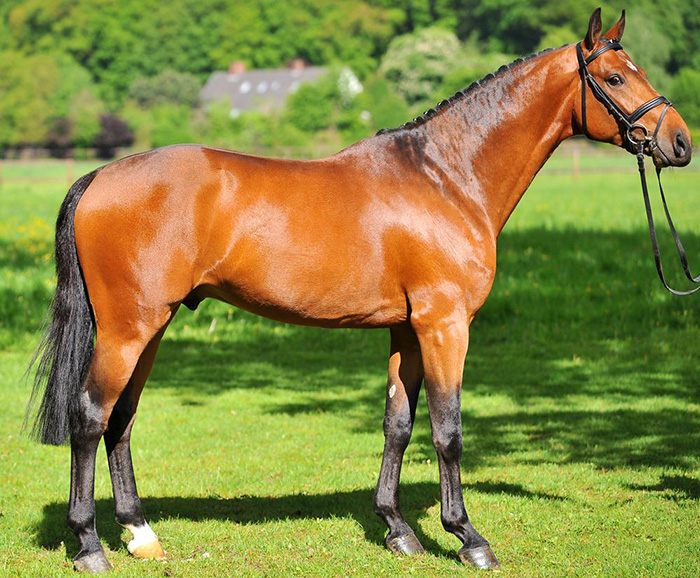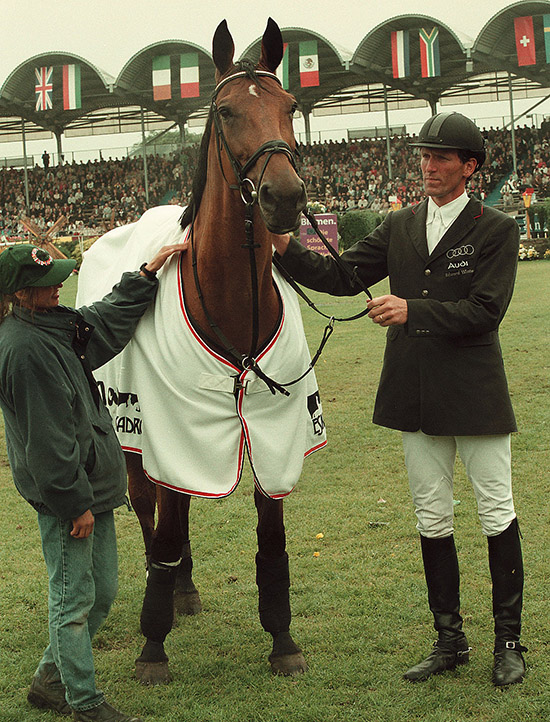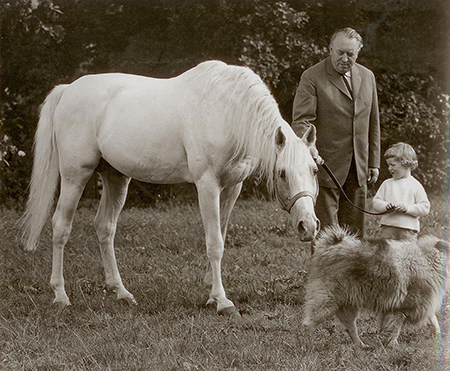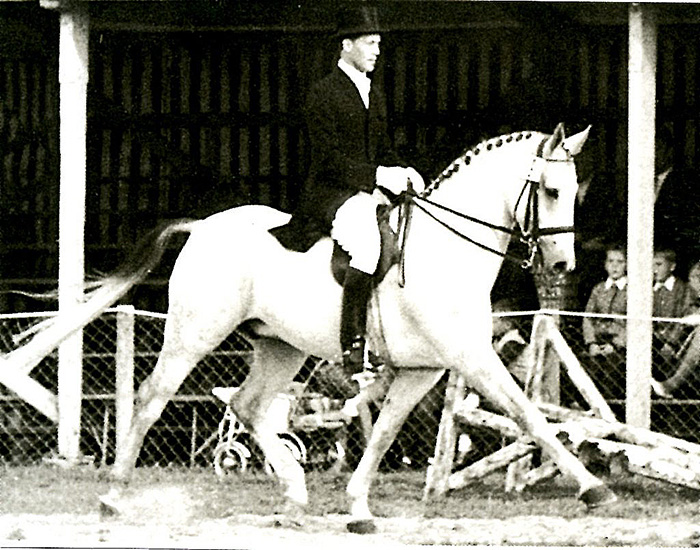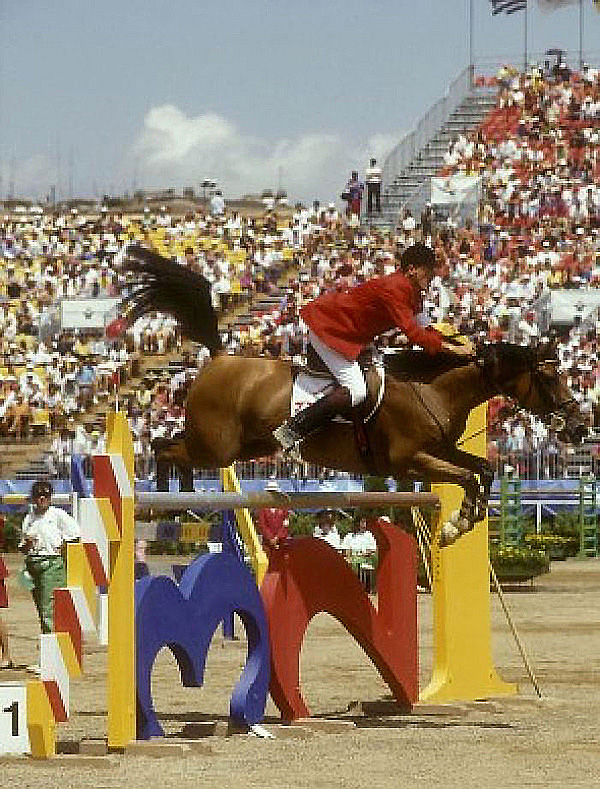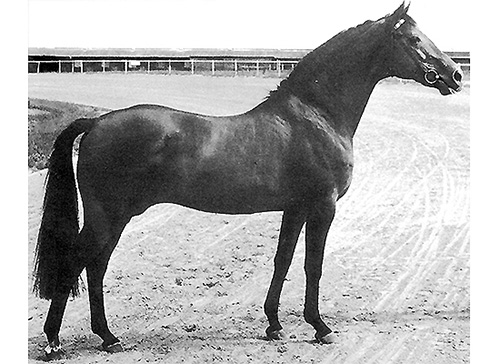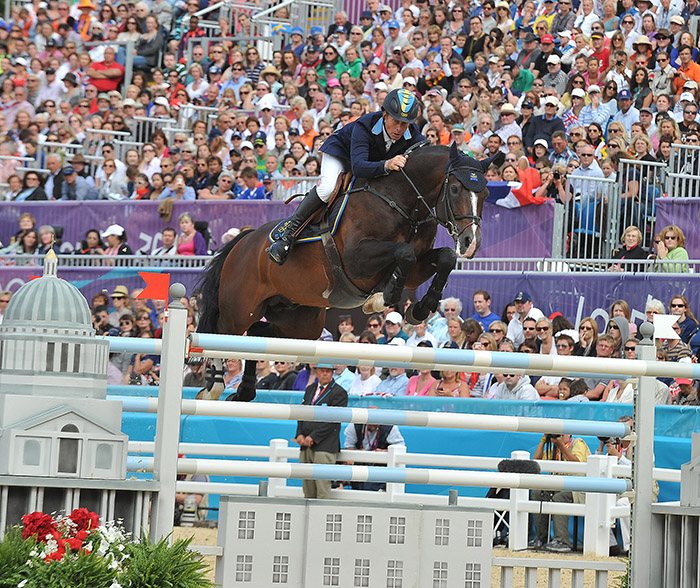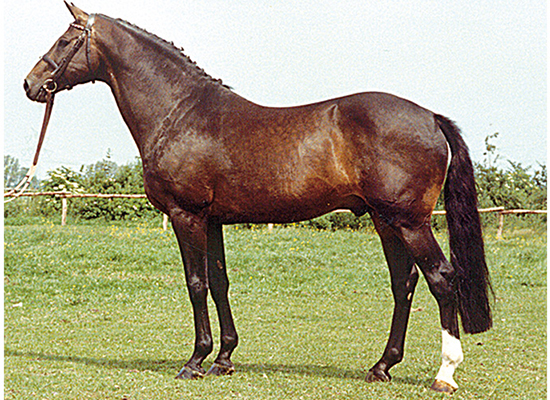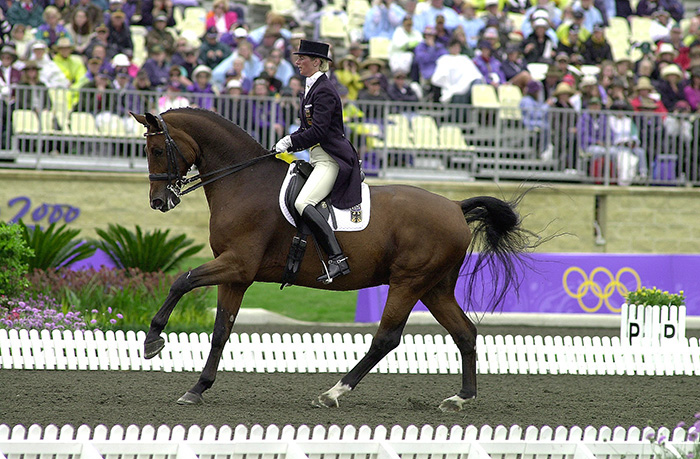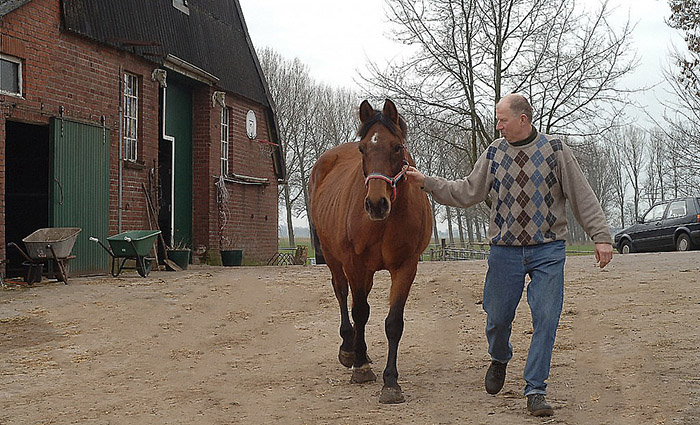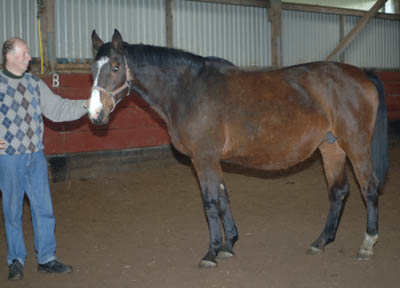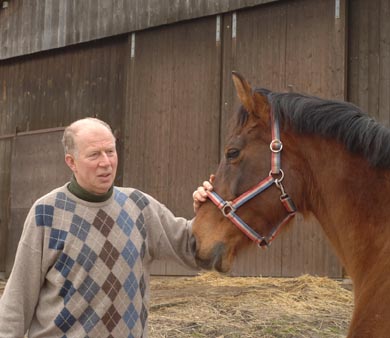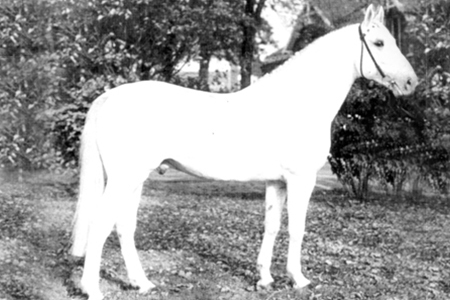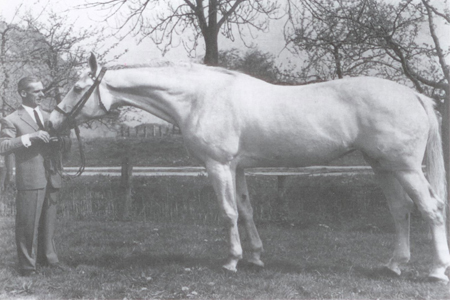by Christopher Hector
I set out to find the greatest showjumping broodmares of them all, and I went to four acknowledged experts to get their nominations: two Germans, Dr Ludwig Christmann and Dr Thomas Nissen, the Dutch expert, Egbert Schep and France’s Arnaud Evain. Little did I realise that really I was starting on the sequel to my book, The Making of the Modern Warmblood – a new book, called The Transformation of the Modern Warmblood…
Here is the first half of what is a very very long article…
Ludwig Christmann
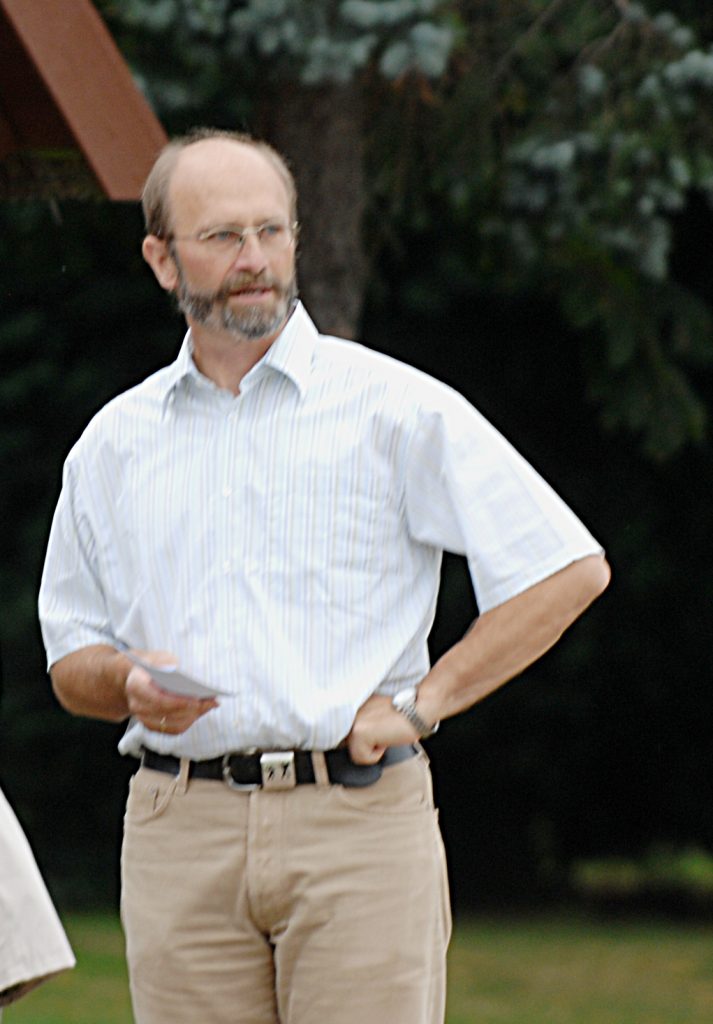
Dr Ludwig Christmann has been a friend and a valued colleague for many many years. He was our group leader on our first Hanoverian Study Tour three decades ago. In his rôle with the Hanoverian Verband as the director of the Department of International Affairs, Ludwig has been instrumental in the development of a world-wide network of Hanoverian breeders, but he is also the mover-and-shaker behind the Hanoverian Jumping program, an important initiative to stop the trend of breeders sending their good jumping mares to dressage sires looking for a better market. He is also a prolific writer, and puts together the Hanoverian Stallion Book every year along with numerous articles on the Hanoverian breed and breeding.
Alsterröschen
Ludwig’s first choice underlines the need to keep alive those old jumping lines – the mare is Alsterröschen by Agram, indeed line bred to Agram. Alsterröschen is represented in the dam line of Stakkato Gold, one of the leading stallions in Germany today and Hanoverian Stallion of the Year 2000 progeny have won €1,253,095.
Agram is one of those names out of ancient history, but perhaps the most interesting aspect of this survey is that while the sport of showjumping has undergone massive changes in terms of the style and demands of the fences, and the showjumper of today looks very different from the old-fashioned Warmblood when you compare the successful ones – you still find those old lines flowing strongly.
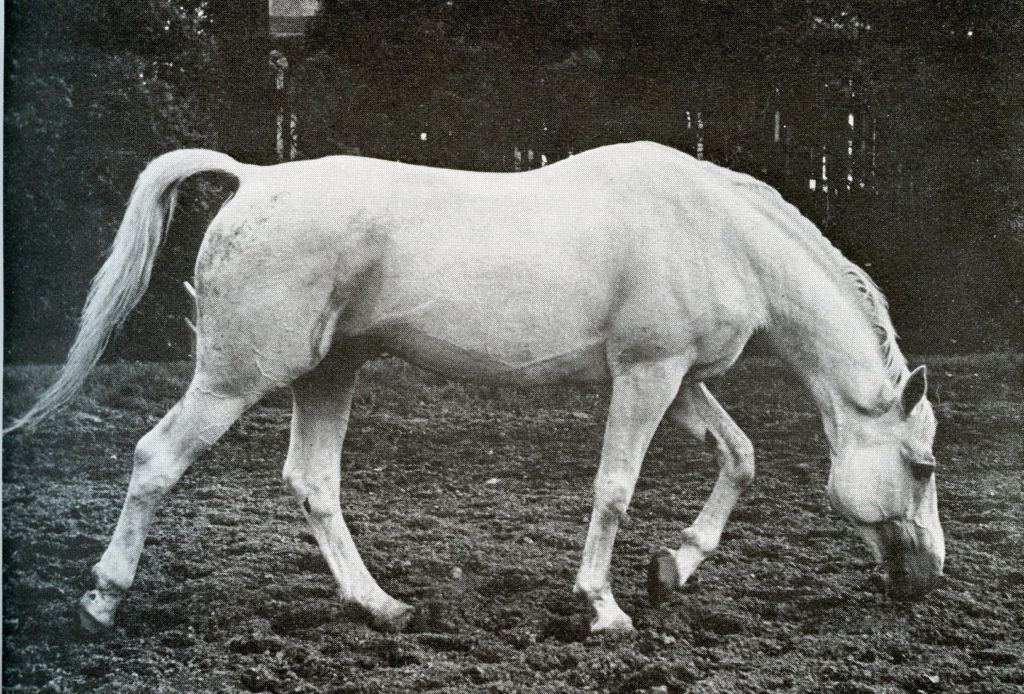
This is Agram, he stood from 1942 until 1962… Agram was by Alkoven I, a descendant of the foundation Thoroughbred, Adeptus, and out of a mare by Amateur who was a descendant of the Shagya Arab stallion, Amurath, who stood at the Celle Stud.
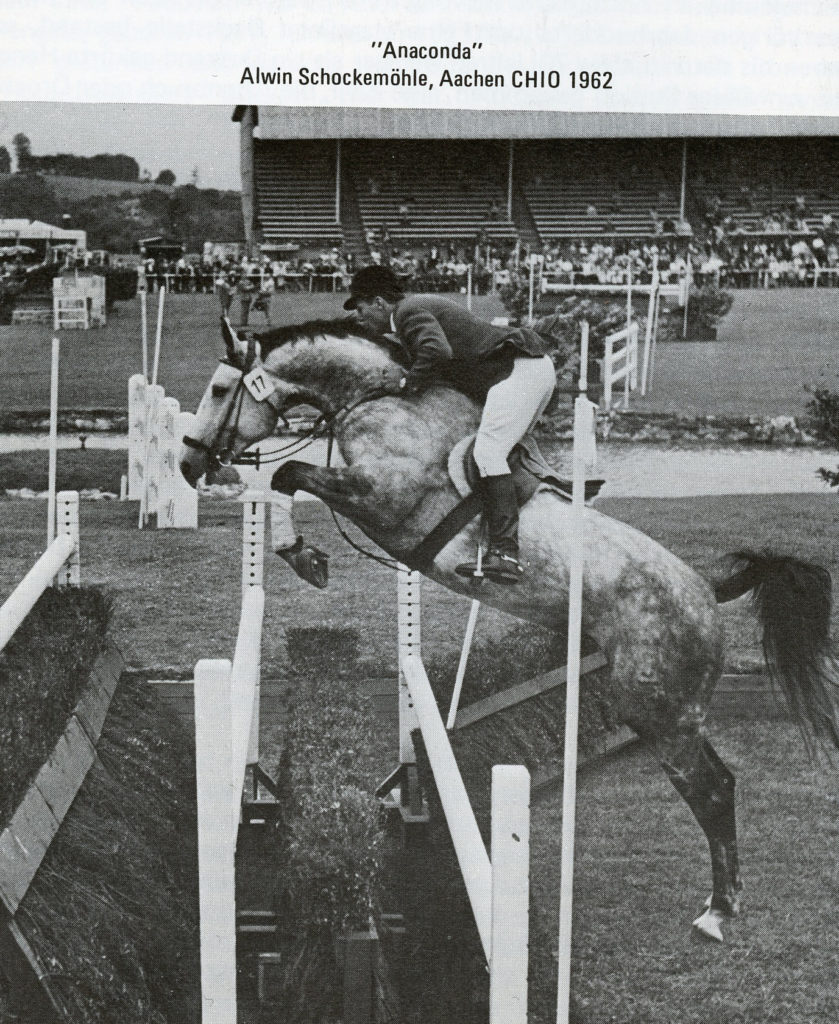
Agram was the sire of numerous international jumpers, including Anaconda (Feudal II) with Alwin Schockemöhle and Mary Chapot, and Paul Schockemöhle’s Askan (Almhügel III)
When we look at the number one jumping sire in Hanover, Stakkato Gold who stands at the Sprehe Stud, we see the influence of the old families and, in particular, Agram.
I am grateful to another of my German friends, Jens Meyer who is a keen student of Hanoverian mare lines:
“I have had many discussions with Paul Schockemöhle about this, how important it is to keep the old families, but on the other hand, how difficult it is, because many of the jumper breeders want to sell foals, and in Germany it is not like Belgium or France where you can sell foals on the pedigree, here you have to have a foal that looks impressive at the foal shows, so there is a danger of losing these families, but when I look at the pedigrees of modern stallions like Grey Top and Stakkato Gold, I am really surprised to see how important the old lines are still.”
Alsterröschen was the product of the breeding program of one those old style breeders who followed their instincts, not the whims of fashion.
Jens tells the story well: “The breeder of Alsterröschen was Franz Luth. He was not happy with the stallions at the local Dannenberg stallion station at the time, and that is why he bred to Agram – at that time they had big strong stallions at Dannenberg, heavy old style horses, and he preferred Agram who was a lighter horse. So he said, I will breed Agram back to an Agram mare, and everybody said, you are stupid, and in the end, the world today must be happy that he has these bloodlines.”
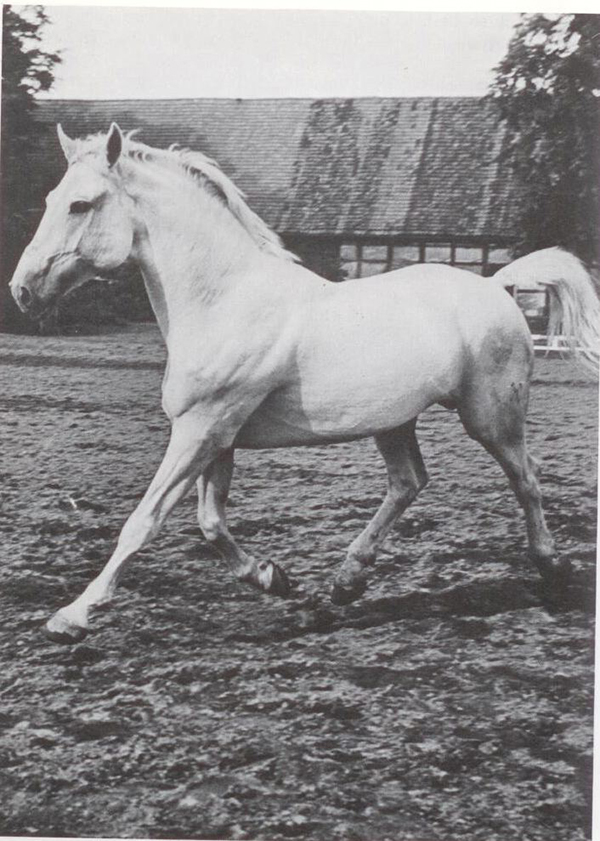
Agram and his dam sire….
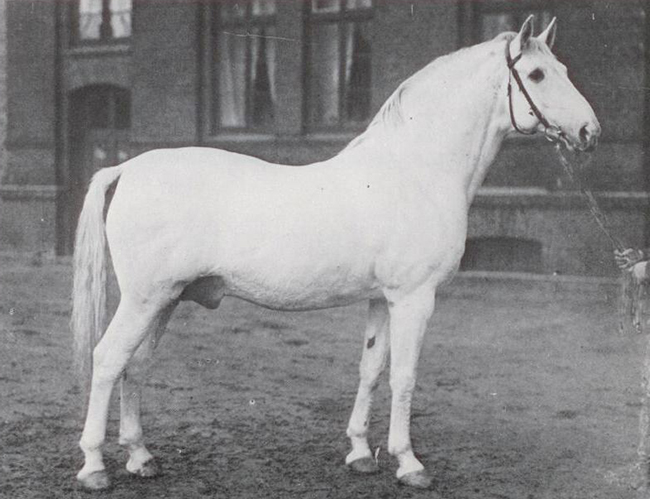
Amateur I
Bred to Domspatz (Dömitz I / Graf) in 1969 Alsterröschen produced Dux Z (Don Rudolpho) who competed 1.50m with Franke Sloothaak, winning a 1.50m GP with Franke at Leeuwarden CSI in 1988. In all she produced seven foals, but it was Wildrose, born in 1980, that earns Alsterröschen her place in this line-up. Again, Jens tells us the story:
“It starts with Algave, she was by Agram out of a mare with just a number, 311516939. Mr Luth bred this mare back to Agram and then comes the mare, Alsterröschen. In 1980 she produces Wildrose by Wienerwald. I was there in ’84 so I knew her as a young horse. She was not a ‘nice’ horse, she was just 6% Thoroughbred so Mr Luth took her to Calypso, the first Holsteiner stallion that Dr Bade brought to Celle, and she produced the filly, Carmen.”
“Then comes Mr Kamphorst from the border near Holland and he buys Carmen from Mr Luth. Where he lives is very close to Jos Lansink, so he breeds to Libero. Mr Luth did not have a son to go on the with the breeding program, but it was possible for another breeder, Arend Kamphorst to keep those lines, and really go straight ahead.”
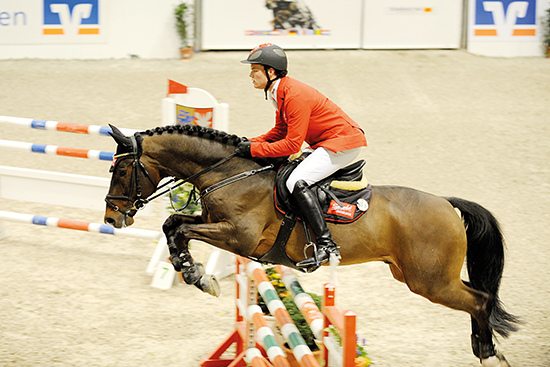
Stakkato Gold
And the Libero filly out of Carmen (the mare by Calypso II out of Wildrose) when bred to Werther, produced Stakkato Gold’s dam, Wertherröschen… “In the 90’s, Werther was very popular, and with Werther we have the mare lines Marcio xx, Dolman, Amateur, so in the end, we have very old breeding, and with this old breeding, we have a perfect match and produce this shiny horse, Stakkato Gold. It was a shame that he was only ridden by a junior rider, but I thought Stakkato Gold had the talent for the big sport.”
Story continues below the advertisement
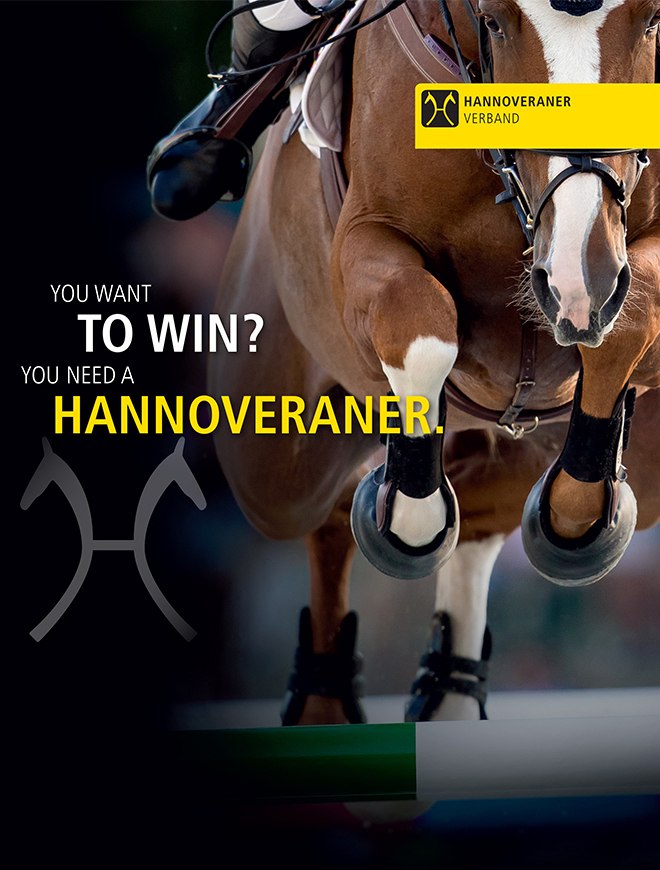
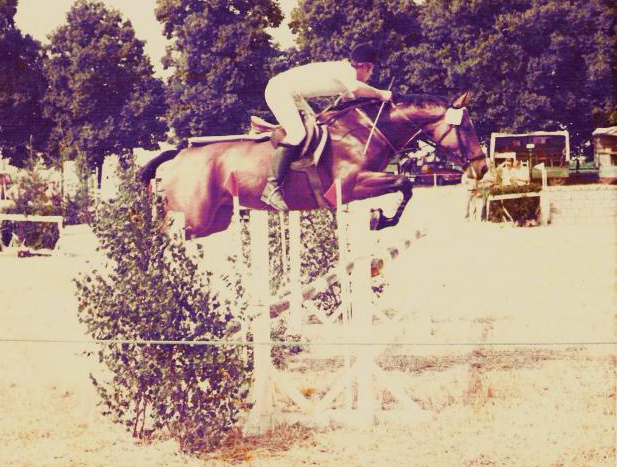
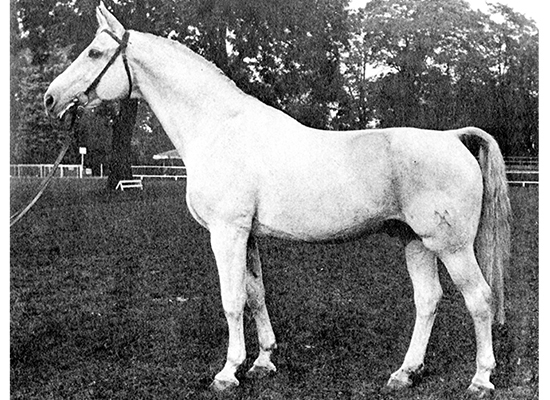
Even though Gotthard never really established a stallion line, he was an outstanding sire of brood mares, there are just so many influential modern stallions with Gotthard on their dam line – and also he was a great producer of top-level competitors.
For seven years Gotthard was the leading sire of showjumpers in Germany. Gotthard was the sire of international showjumpers: Goya, Goldika, Gonzales, Galipolis, Queensway Big Q, Goldfink, Golden Gate, Graf Sieno and Graf 2. Gotthard’s son, Genever sired Genius, the World Cup Showjumping Champion of 1992. Another son, Goldpilz is the sire of John Whitaker’s Gamon.
Gotthard shone as a broodmare sire, and he was responsible for 25 States Premium mares. World Cup winner, The Natural (by Diskus) is out of a Gotthard mare, and Voltaire, the hugely influential Dutch based Hanoverian jumping sire, was similarly out of a Gotthard dam. Indeed Gotthard mares formed the basis of Léon Melchior’s Zangersheide stud, then Studbook, of jumping horses.
The great breeding expert Werner Schockemöhle, in his text Die Grossen Hengste Hannovers, described Gotthard as ‘lucky’ to be accepted into the stallion ranks at Celle:
“At the time he was not really ready. He looked weak and lacking in his expression – he was not developed sufficiently in the shoulder and in the formation of his neck. No one could guess at the time how lovely and expressive the horse would be ten years later. The fully matured Gotthard impressed through his perfect shoulder and his perfect neck, and even his head could be classed as nice – even though he had too strong cheek bones from his Arabian ancestry, otherwise the head was clear and dry with a wide forehead and a lovely big eye. His croup could have been a little longer and a little bit more sloped in the top line. His hind legs were quite good, but you have to admit that his hocks could have been better.”
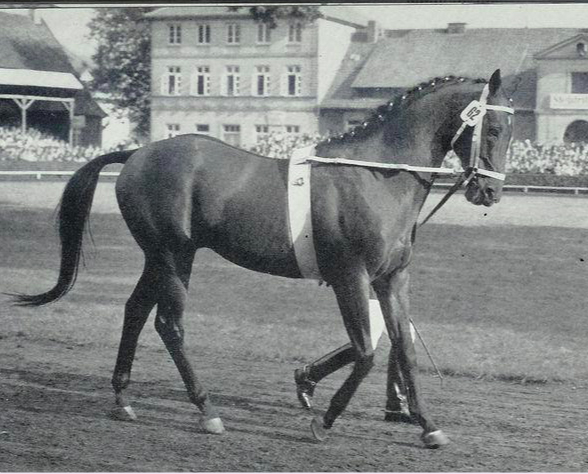
Perser xx
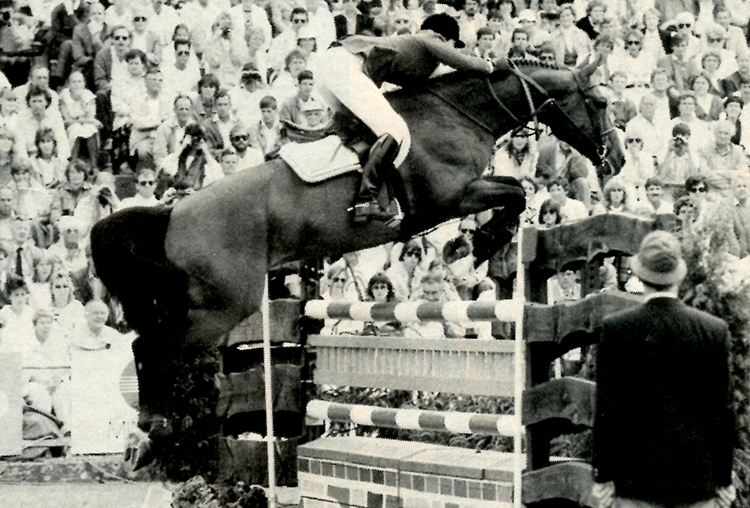
“The mare Goldbanner was a jumper, she competed at one twenty, one forty classes, ridden by Heinz Böttcher’s two sons. The interesting thing is the Thoroughbred breeding, there comes Perser xx, he was a jumping horse producer, then we have Sellhorn by Senator, from our own S line, and finally, the great grandmother, Kemenate, she is by the Trakehner, Keith, who is also on the pedigree of Pilot.”
“It’s always interesting to see that those pedigrees have enough Thoroughbred and Trakehner in them. She was bred in the Stade area, and even in those older times, these were riding horses, there was no draft horses – or Warmblood horses in the type of draft horses – in their breeding. When the wealthy people had horses, they had more riding horses.”
Does the Böttcher family still breed horses?
“They are still breeders, they had success with this line but now they are doing more with dressage horses…”
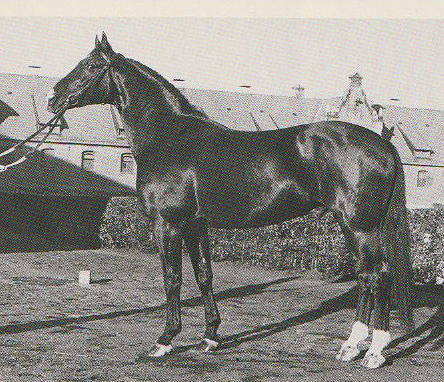
Diskus
“The most famous horse from this mare, The Natural, is by Diskus (Domspatz / Senat) – I was at the station where he stood, Sulingen, in 1980. He was a fashionable horse. The State Stud leased him to Paul Schockemöhle, so after the season, Diskus would go for six weeks to Paul Schockemöhle to breed Paul’s mares. For the bloodlines he had, Diskus was a light horse, he was not the easiest with the temperament. He was a real stallion, always nipping a bit and he was lazy covering mares, ooh so lazy, you cannot imagine how many hours I spent with him in the breeding room with the mares…”
Gute Sitte
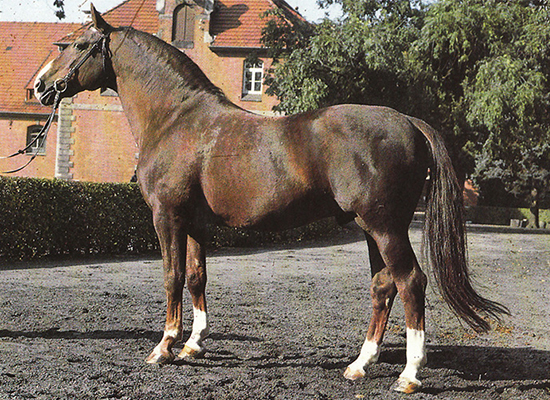
Gute Sitte’s sire was Grande (Graf / Duellant) who was lucky to be born in an era when the breeders were prepared to trust the wisdom of the head of the state stud Celle, the attitude was if he sends us a stallion, then we send our mares to him.Grande was little (just a touch under 16 hands) and not terribly impressive to look at.
Dr Bade, long time head of Celle, cheerfully agreed that one of the greats of breeding would not have made it if he had come before one of the modern licensing commissions:
“Oh, Grande wouldn’t be licensed. But that is the success of our breeding! At the time he was licensed – I believe there were discussions at that time even – because he was anything other than a riding horse, but he was of a good bloodline.”
As it turned out Grande went on to produce 33 approved sons, 34 states premium mares and top showjumping progeny like Grande Giso and Gute Sitte. His grand children seem to have been the real stars – Galapagos with Gabriella Grillo represented Germany at the 1982 World Dressage Championships, and was one of the leading lights of the ‘new’ class, Freestyle Dressage to Music. Grandeur (Gralsritter) won over a million Deutschmarks in a spectacular showjumping career, and since then has proven himself as a superior sire.
As a competitor, Gute Sitte was a frontline competitor, and ridden by Eric Wauters, she was part of the bronze medal winning Belgian team at the Montreal Olympics in 1976. As a brood mare, she produced three foals. in 1981, the mare, Erle Sitte (Kini),1982, the stallion, Feine Sitte (Lugano van la Roche) and in 1985, the brood mare, Insel Sitte (Major de la Cour) who bred to Avontuur, produced the 150 jumper, Ialta Sitte, with Darco, the approved stallion, Ksar Sitte, and with Carthago, Cordano Sitte Z, who jumped 1.60 with Morrocco’s Abdel Kebit Ouaddar.
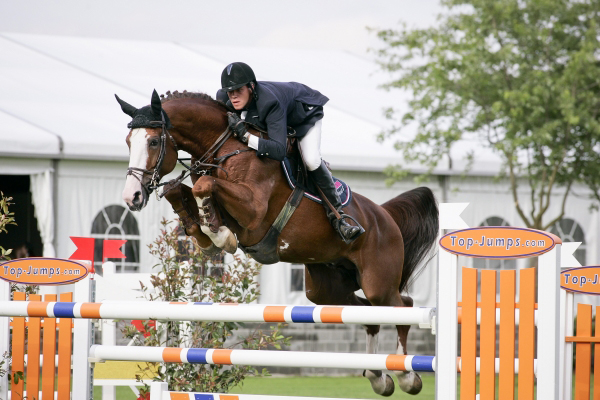
Ogano Sitte
As a brood mare Ialta Sitte was a sensation. Her most famous foal is Ogano Sitte by Darco. He had one win at 1.60 level with Dominique Hendrickx and has since gone on to be an important sire. Ogano has produced one 1.65 jumper, Thelma la Tour (Calvaro), and the current hot stallion Aganix du Seigneur (Chellano) along with another thirty five 1.60 jumpers.
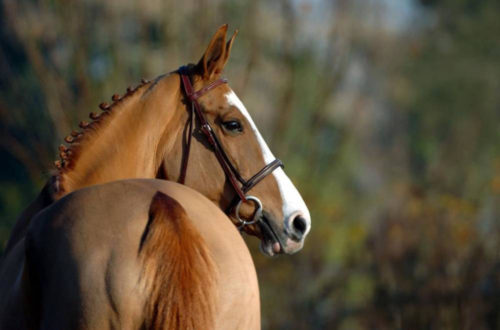
Insel Sitte
Insel Sitte bred to Aramis de la Cense produced Atlanta Sitte who was another sensational broodmare. Atlanta was the dam of Callas-Sitte (Calvaro) a 1.60 winner with Christina Liebherr and dam of another 1.60 competitor Rivella Sitte (Kannan).
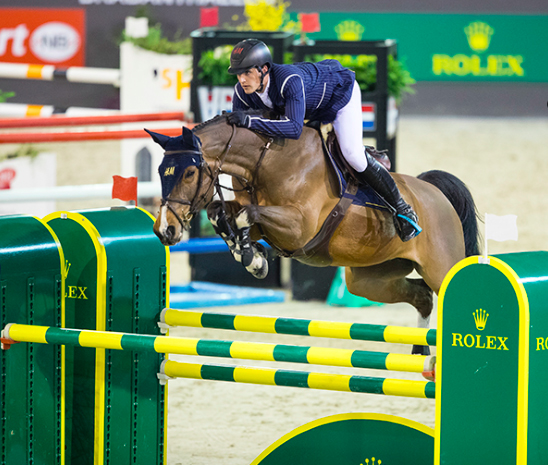
Ustina Sitte
Atlanta is the dam of Riviera Sitte (Parco) who jumped 1.50, and is the dam of Ustina Sitte (Clinton), 1.60 with Nicola Philippaerts and Button Sitte (Ogano Sitte), 1.60 with Ireland’s Richie Moloney. Atlanta Sitte’s daughter by Nabab de Rêve, Nacre du Seigneur is the dam of Alcazar Sitte (Rexar du Houssolt) a 1.60 jumper with Japan’s Mike Kawai.
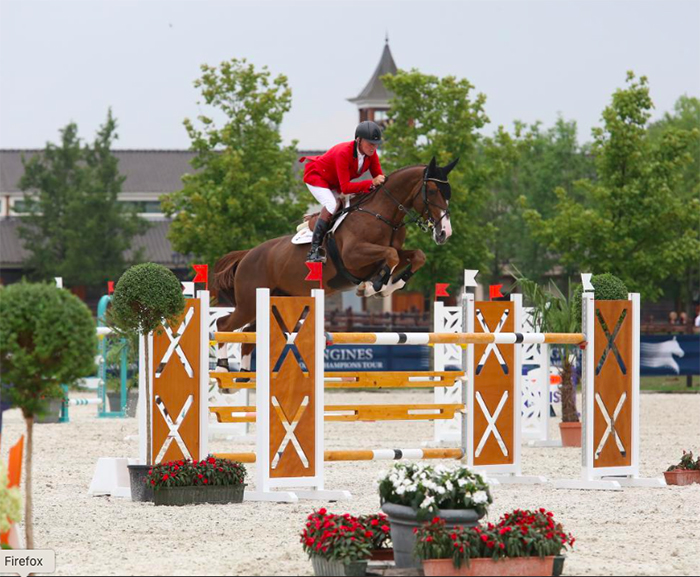
Aganix du Seigneur
Another Atlanta daughter, Cadix du Seigneur (Chellano Z) produced Arsouille du Seigneur (Schilling), 1.60 with France’s Robert Breul along with Aganix du Seigneur (Ogano Sitte), 1.60 with Jos Lansink and another 1.60 jumper, Eganix du Seigneur (Ogano Sitte).
The Atlanta son, Atlanta du Seigneur (Schilling) has had one win and five placings at 1.60 level with Gudrum Patteet.
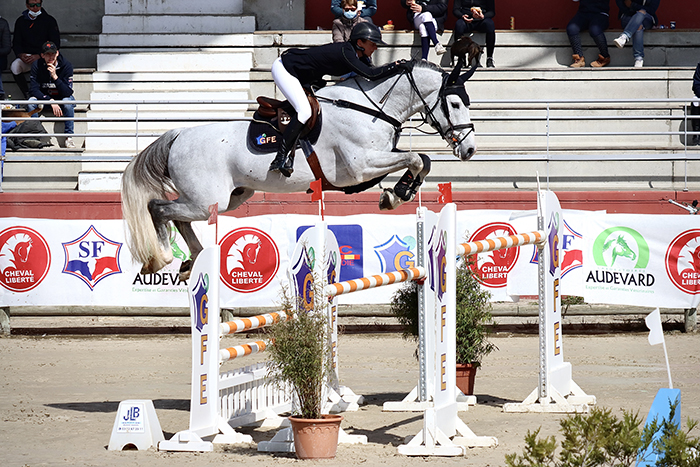
GFE Excalibur de la Tour Vidal
The blood of Gute Sitte continues to produce great results. At the Grand Prix of Rome in May 2021, Penelope Leprevost was 4th in a 1.60 Grand Prix with GFE Excalibur de la Tour Vidal. The grey stallion is by Ogano Sitte and out of Thelma la Tour Vidal who is also by Ogano Sitte. Excalibur has won €168,098 so far, Penelope rode him in 7-year-old classes in 2017, and 2020 was their first year competing 1.60m.
Story continues below the advertisement
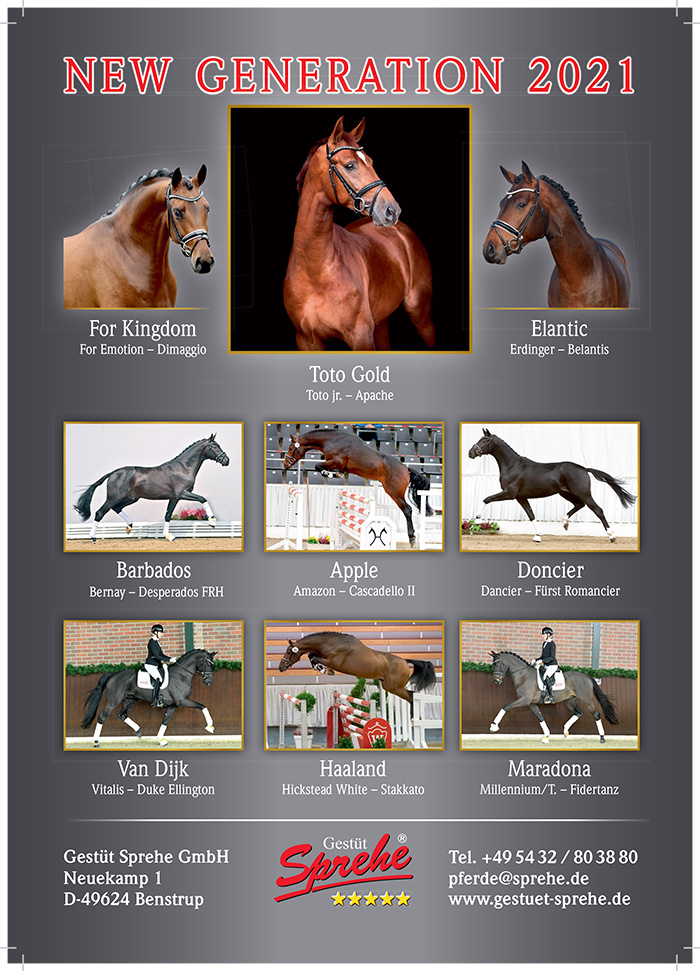
Ratina Z
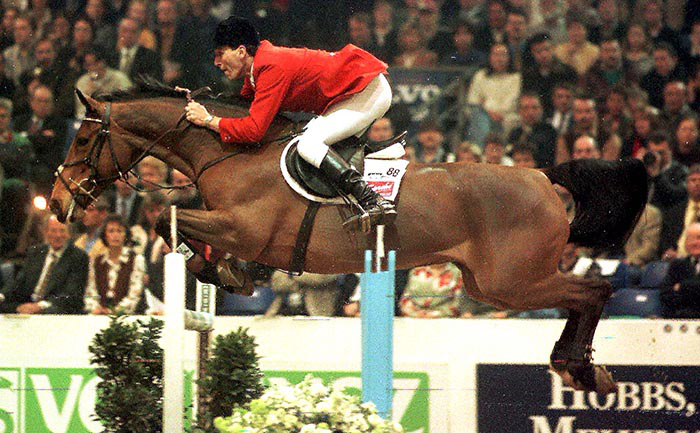
Rounding out Ludwig’s quartet is Ratina Z. This is something of a controversial selection, indeed, the distinguished Dutch Breeder, and veterinarian, Jan Greve uses Ratina as an example to support his argument that you can’t combine breeding and a competition career:
“I’m not sure why this happens but it seems to me that you cannot use the animal’s body twice – to have it a showjumper until it is 14/15 and then into the breeding, it hardly ever works. Ratina didn’t work. It might just be that it is too much to expect from the body. It’s funny but every body has a certain age when it produces the best, with a milking cow, it is the third to the fifth calf that gives more milk. I cannot explain why it happens with horses but it does seem that you can’t use the body double, to be a good sporthorse and then to be a good producer.”
A memorial to Ratina…
Admittedly, Jan made this statement some years before Ratina’s son, Comme il Faut (Cornet Obolensky) appeared on the scene, but the fact remains that Ratina and her clones produced many many foals, but not many of them were top competitors and one of her more successful products was Calipa who was Ratina’s first foal, born before the mare’s jumping career got serious.
First to Ratina’s breeding. She is the product of the founding philosophy of Léon Melchior’s Zangersheide Stud as the late Mr Melchior explained to me in an interview in 1993:
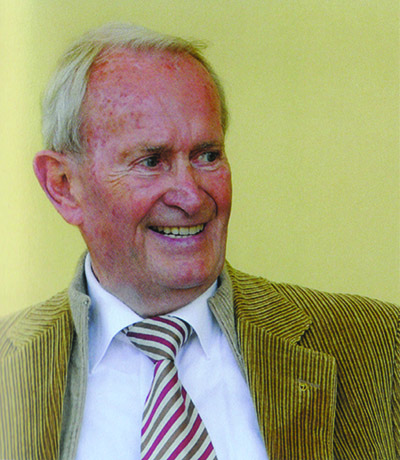
“If you start in Hanover with the best level of jumping horse you can find, that means you start with Gotthard and horses like that, then you have to cover those mares with another good horse – so you go to a horse like Almé. Why? Because Almé is from France, very far away from Hanover, and you get the outcross effect. The outcross effect means that if you have two or three breeds of dog, they are always more healthy if you cross them than if you keep line breeding the same breed of dog. If you cross two different horse lines then the result is stronger, healthier, more robust.”
“So that’s what we did with the next generation from Almé. If you cross the result with the best of the English Thoroughbred and the Arabian from Ramzes, that’s what we had in Ramiro – then we are once again crossing a completely different way – the out-cross effect again. Then with the results of breeding with Almé and Ramiro, we can cross them again without any danger at all – then you have the best results of inbreeding.”
Rantina is by Ramiro, and out of the mare, Argentina Z by Almé out of the founding mare of the stud, Heureka, a top jumper in her own right, and winner of the Aachen Grand Prix in 1970 with Hermann Schridde. Although Heureka was branded Hanoverian, her breeding was entirely Holsteiner, by Ganeff out of a Falerner mare.
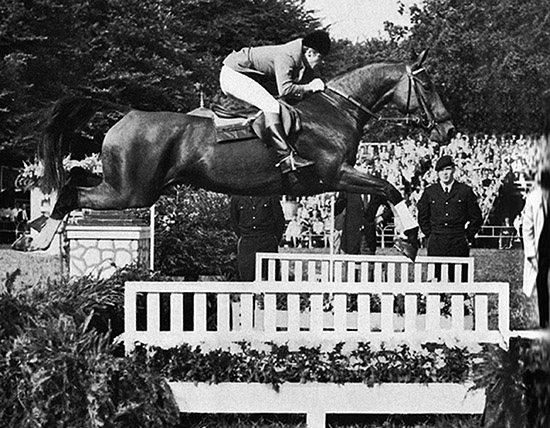
Heureka
When he established his stud, Melchior was registering his horses with the Hanoverian Verband, but as the percentage of Hanoverian dropped and dropped until it was virtually non-existent, the marriage of convenience led to divorce and the founding of the Zangersheide Studbook in 1992.
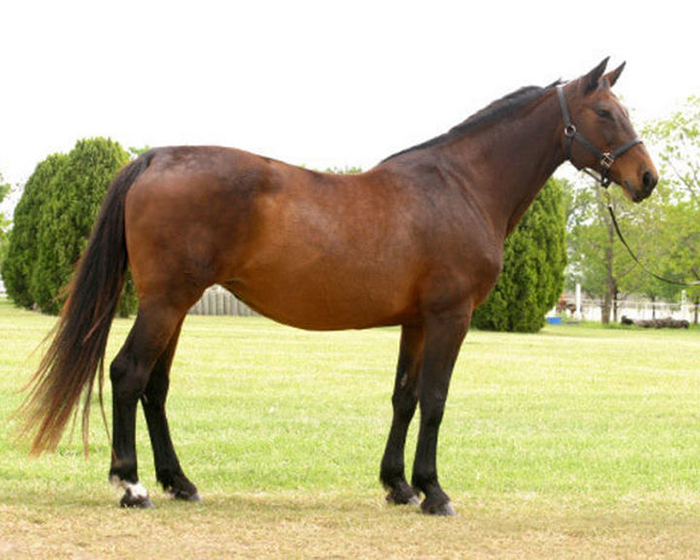
Calipa Z – Ratina’s most successful brood mare daughter…
Ratina had her first foal as a four-year-old, Calipa Z by Cor de la Bryère – in keeping with his motto the best to the best, Melchior leased Corde from the Holstein Verband for one season, 1985. After producing a couple of stallions that disappeared, Calipa foaled Chicago I Z by Caretano. Although Melchior complained about people dropping the Z from his horses names, he more than made up for it by decorating any horse that came into his hands, even horses that he had had nothing to do with their breeding, with the letter Z. Caretano was born in Holstein to a Holstein breeder and was by Caretino out of a Reichsgraf mare. Thus Caretano, one of the most successful of the Z stallions, acquired the suffix after his purchase, sort of branding by chequebook.
Calipa produced three more 1.60 jumpers. The stallion, Camillo La Silla (by Montebello La Silla, more branding by cheque book, this stallion started life as Portofino and was Westfalien through-and-through – by Polydor out of a Parademarsch mare….) Camillo had ten placings at 1.60 with Jeroen Dubbeldam.
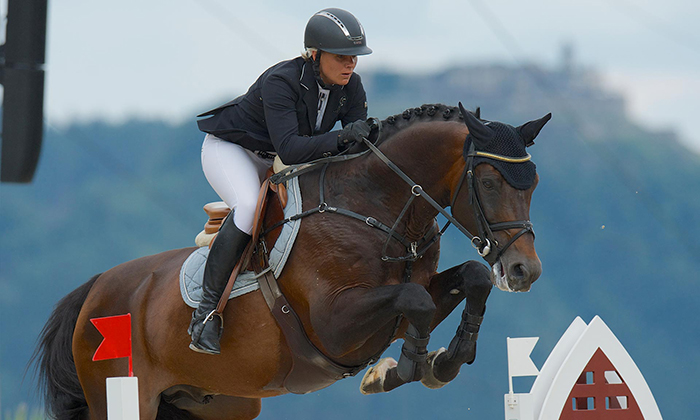
Sterrehof’s Cayetano Z
Another stallion, Sterrehof’s Cayetano Z (Caretano) had two wins and 15 placings at 1.60 with Austria’s Julia Houtzager-Kayser.
Back to Ratina, her 1988 colt foal, Rex Z, illustrated Melchior’s belief that once he had his outcrosses, he could breed the progeny close without the risk of inbreeding. So covering Ratina with her full-brother Rebel Z I, produced Rex Z. Like his sire, Rex Z was not hugely successful at stud and does not seem to have competed.
Crown Z
2000 saw Ratina produce three foals, the mare Clever Z (Carthago), Treasure Z (by Tlaloc la Silla) who jumped 1.60 with the Egyptian Wael Mahgery, their best placing 9th in the CSI2 Alexandria, and Crown Z, who competed with Melchior’s daughter, Judy Ann at 1.60 level, with one placing at 1.50.
Comme Il Faut – Ratina’s only real star
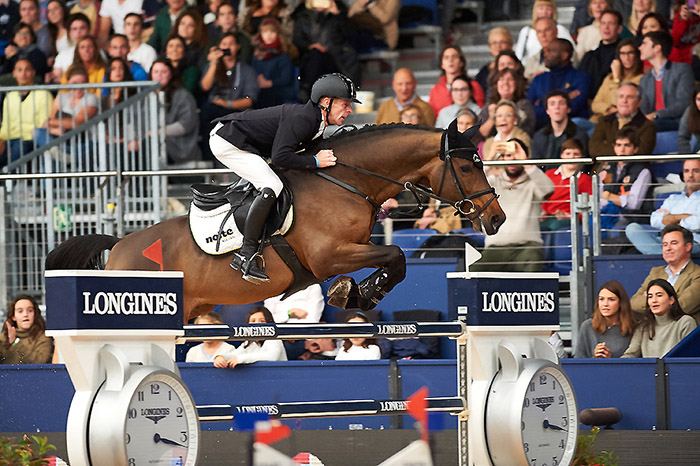
Comme il Faut, a winner with Marcus Ehning
In 2005 Ratina at last produced a genuine superstar, Comme il Faut by the great Cornet Obolensky. Six wins and 35 placings at 1.60 (six 5* wins) with Marcus Ehning.
Ratina herself is listed with fourteen offspring but she was also cloned on a number of occasions, thus we have Ratina Gamma Z, Ratina Alpha Z, Ratina Beta Z and Ratina Delta Z. So far as I can tell, not one of them produced a 1.60 jumper.
Ratina Z and Ludger Beerbaum at her competition retirement at Aachen
Ratina Z was retired as a broodmare in 2005, and lived the rest of her life at the stables of Ludger Beerbaum. She died in 2010 at the age of 28…
Thomas Nissen

At the end of 2020, Dr Thomas Nissen retired after 32 years as the breeding manager of the Holsteiner horse and as the Verband’s director. In 1988, following his final university examination, Dr Nissen became the breeding manager of the Holsteiner Verband, taking over from Gerhard Gramann.
Dr Nissen had been always a promoter of the targeted use of outside stallions, especially English Thoroughbreds and French sires which had great influence on refining and modernization in the Holsteiner horse. Here is his response to my request for the five best mares, and not surprisingly given the key rôle the Holsteiner has played in the development of jumping breeding throughout the world, he came up with a rather larger list, saying ‘take your pick they are all top mares’:
Waage I v. Calypso II – Royal Wash xx (Stamm 4965) u.a. Clinton I + II and Hirtin u.a. mother from Levisto
Ungarin III v. Fernando – Roman (Stamm 4063) u.a. Lambada and Jefferson
Furgund v. Colombo – Herwin (Stamm 7673) u.a. Calando I to V
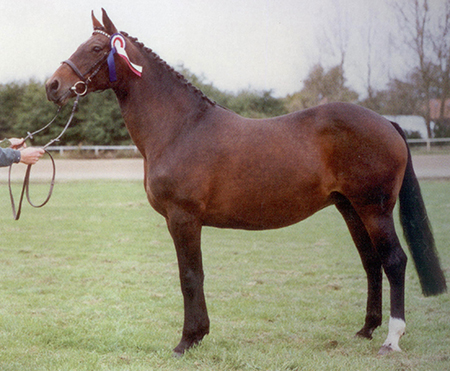
Ramiro was by Raimond, by the Anglo Arab Ramzes out of a mare by the Holsteiner Fanatiker.
Ramzes was foaled in 1937 in Poland, he was by the Belgian bred Thoroughbred – and successful racehorse – Rittersporn, who was a grand-son of the great French Thoroughbred jumping sire, Le Sancy. Ramzes was out of the Shagya Arab mare, Jordi. During the war, Ramzes was stabled at the Polish Stud, Janow Podlaski, where he was a popular riding and carriage horse. With the Russian forces advancing, the Polish studs that were under German occupation were relocated to Germany, and Ramzes was one of the horses that crossed the border. He was purchased by Clemens Freiherr von Nagel, who bred sport horses at his property in Vornholz in Westphalia. He knew Ramzes from his time as Director of the Polish Racot Stud during the war.
Baron von Nagel and Ramzes
The Westfalien studbook was not impressed with Ramzes and he stood at the Holstein Stud in 1951 and 1952, to refine the heavy Warmblood horses of the area. The first foals that were born in Holstein in 1952 were disappointing, they were lightly built, not very big and difficult to sell – many ended in the slaughter house. It was also difficult for his sons to be licensed, their cannon bone circumference of around 20 cm was considered very fine in an era where 24 cm was a more common measurement for stallions.
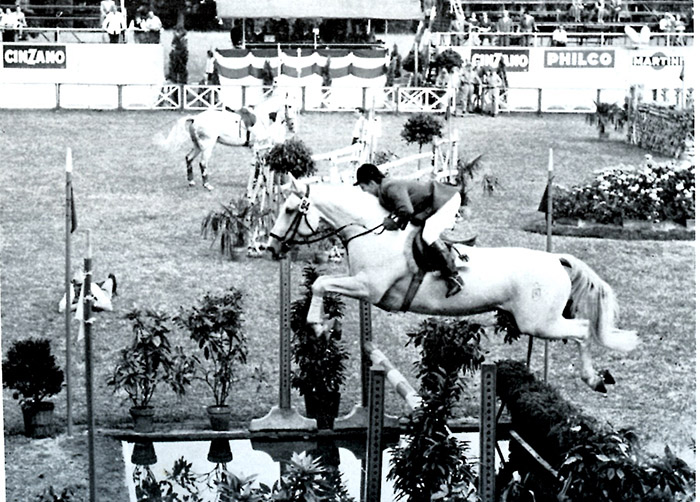
Ramona and Alwin Schockemöhle
But his jumping offspring from that first period in Holstein turned the tables. They were stars: Retina, ridden by Fritz Thiedemann, Romanus with Hans Günther Winkler, Ramzes XIII with Kurt Jarasinkski and Ramona with Alwin Schockemöhle, established Ramzes’ fame in Holstein, and resulted in him standing there for two more seasons, in 1959 and 1960.
Four licensed stallions were bred in the second stud period in Holstein: Roman, Rigoletto, Raimond and Rhenus. Rigoletto was sold to The Netherlands, while Rhenus ended his days in the circus tent. Roman became a good competition horse, and an excellent sire of broodmares. Raimond was a more attractive type than Roman and sired over 120 daughters and eight stallions, but of these, only Ramiro was a success.
While in Holstein, Ramzes bred showjumpers, in Westfalia, he produced dressage horses. The Ramzes son, Remus won individual dressage silver and team gold at the Tokyo Olympics, where he was ridden by Harry Boldt.
Harry Boldt and Remus
Two years later, another son, Mariano, ridden by Josef Neckermann, won the World Dressage Championship, with Remus collecting another silver medal. Mariano won silver at the 1968 Games – and four years later, at the Munich Games, another son, Robin was a member of the German gold medal winning showjumping team.
Based at the Zangersheide Stud, Ramiro was presented with a selection of superbly bred jumping mares. His most famous ‘nick’ was with the foundation mare, Heureka (Hanoverian branded, but all Holsteiner blood, Gaenff / Falerner.) Argentina Z, the Heureka daughter by Almé, produced with Ramiro the stallion sons: Rebel I Z, Rebel II Z, Rebel III Z and Rock Z, none of whom were wildly successful, but their full-sister Ratina Z was a superstar. Ridden by Piet Raymakers and Ludger Beerbaum, she won World Cup Finals, the European Championships, the Grand Prix of Aachen, individual Olympic Silver, double Olympic Team Gold, Team Gold at the WEG, and twice team gold at the European championships.
Ratina – superstar
Bred to Almé, Heureka produced Ahorn Z who was to take the blood of the French champion into Holstein thanks to the visionary Maas J Hell.
Like his grandsire, Ramzes, Ramiro was more a broodmare producer than a stallion maker.
Gofine was out of a mare by one of the Thoroughbred stallions who played a key rôle in transforming the Holstein horse from an agricultural worker to a sports star – Ladykiller.
Ladykiller, 35 stallion sons
Ladykiller was born in England in 1961 but he was no hero on the racetrack, racing three times in two years and rating only a 80.5 kilo handicap – which luckily for him, was 0.5 kilos more than the minimum required for a Thoroughbred stallion to be accepted into German breeding ranks. Before his death in 1979, he sired 35 stallion sons including the twin pillars of Holstein sport horse breeding: Landgraf and Lord. Both, it should be noted, out of mares with a good percentage of Thoroughbred blood – Lord’s dam was a full blood, while Landgraf’s dam was 25% Thoroughbred.
Ladykiller’s breeding features all the usual suspects found on jumping Thoroughbred pedigrees – Blue Peter, Phalaris, Son in Law – the great descendants of Bay Ronald.
According to The Holsteiner Horse: “Gofine was a classically bred mare from the Haseldorfer Marsh. The sires that appear on the dam line were all stud stallions at the Haselau Station… Niko Detlef, who was looking specifically for a Ramiro daughter, bought Gofine was a three-year-old from Max Detjens of Seestermühle… In 20 breeding years Gofine gave birth to 17 foals, all of whom, with the exception of the mare Goldküste by Lord, competed in sport. The mare Ulina by Chicago was a particularly successful jumping horse and Susanne Behring claimed the German Championship title with her in 1992. Ulina’s grand-daughter, Think Twice by Corrado I, achieved many victories and placings on the international jumping circuit with the Dutch rider Leopold van Asten.”
“The offspring of Gofine’s daughters also achieved convincing sporting performances: Fine Kiss by Caletto I out of M-Laureen by Leander took part in the 2002 World Championships in Jerez and at the 2003 European Championship in Doneaueschingen with the Austrian rider, Tatjana Freytag von Loringhoven. The full-brother to Fine Kiss, Calisken, was ridden by the American rider, Candice Schlom-King. Akelei by Landgraf I was the dam of the controversial winner of the stallion licensing in 1992. Cassandro, who unfortunately was not stationed in Holstein. In the year 2000 the Italian rider, Jerry Smit, won the Grand Prix of s’Hertogenbosch with the stallion as well as recording many further victories with him.”
]In 1984, Niko Detlef bred Gofine to Calypso II, and she foaled one of the most influential stallions of modern times – Contender.
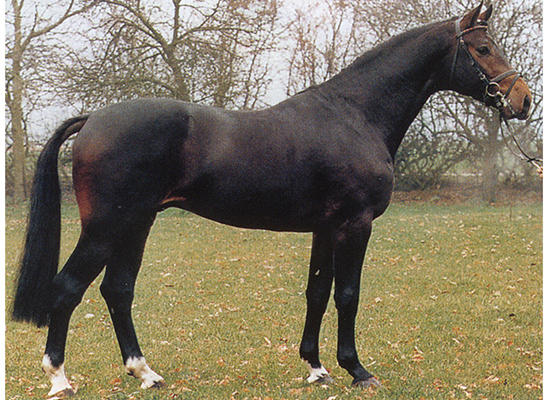
Contender
Four years later, covered by Caletto I, Gofine produced another influential stallion, Cornetto, who was a 1.60 competitor (ninth at the 1999 World Cup final) with Lars Pedersen, although he has not been as influential as a sire as Contender.
Deka
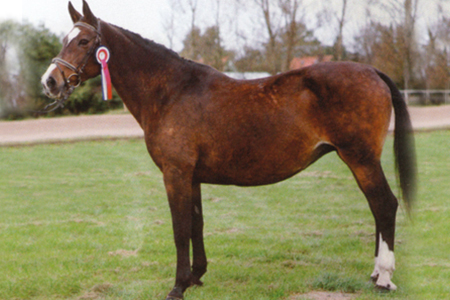
Once again I turn to the authoritative The Holsteiner Horse by Dr Thomas Nissen, Gabriele Pochhammer, Donate von Preußen and Joachim Tietz:
“The mare Deka by Consul, descends from line 730b… This mare is part of Holsteiner breed history. In addition to the two stallions Caletto I and II, she also produced, when paired with Cor de la Bryère, the winning mare of the elite mare show in 1976, Legende, who competed successfully in eventing under the name Cordeka with Herbert Blöcker. Deka was also the dam of the stallion Gonzales by Grandioso, with whom Peter Weinberg and Hugo Simon won numerous advanced jumping classes and who was stationed in Wöhrden after his sports career.
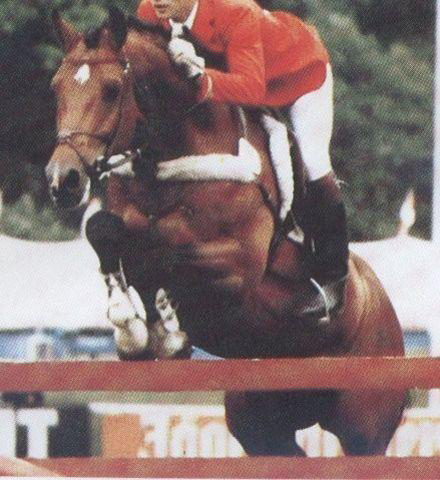
Gonzales – international jumper, sire….
A further Deka daughter, Nathalie (Follywise xx), produced the stallion, Telstar by Nimmerdor in the Netherlands. The stallion Lysander by Landgraf I, had a very promising sporting career ahead of him, but unfortunately this was brought to a premature end due to an injury. He was then licensed in Switzerland, where he was used as a stud stallion for many years. A full-sister to Lysander, Landrätin, won the Young Riders European title under Hauke Luther in 1986 in Reims.”
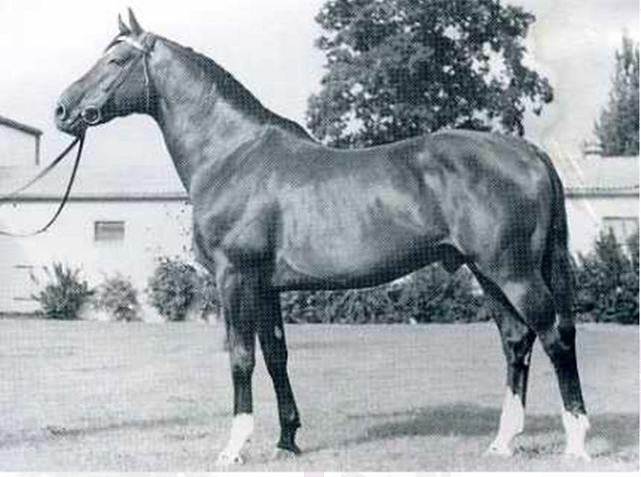
Consul
Deka’s sire Consul is described by that most knowledgeable of breeding commentators, Claus Schridde, as “noble, bay, and the best stallion son of Cottage Son. He typified the horse of a grand exterior and good inner values; he was muscular with a good shoulder formation, had a very impressive profile, and knew exactly how to move. His good foundation was slightly affected by minor displacement at the left front. He was self-confident and filled with temperament. His ridability suffered under tension, and he couldn’t sufficiently be tested in the long run because of a coffin bone fracture. There were times when tension and temper outbreaks were observed with his more colorful offspring. All the same, he is considered to be an absolute positive genetic transmitter and, in today’s day, has become the valued, resounding transmitter of the brawny and fighting spirit.”
The only stallion son of Consul to make a mark was Joost (out of an Anblick xx mare) who was exported to Holland. Consul’s most successful foal was Granat, a dressage star with Christine Stückelberger (World Champion in 1978, and individual gold medallist at the Alternative Olympics in 1980). Granat was out of Salmei, who was one year older than her full sister, Tabelle, the dam of the Calypso brothers.
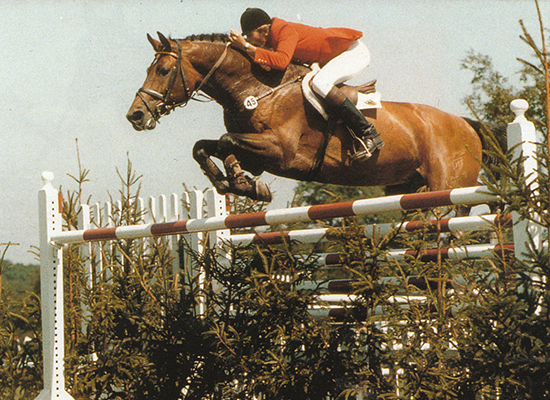
Caletto I
The Caletto brothers continue to have enormous influence over jumping breeding. One of the dominating sires of the moment is Chacco-Blue, whose sire, Chambertin is a grandson of Caletto I. Caletto I is also the sire of Calvaro who was a superstar jumper with a number of riders, competing at the Sydney Games with John Whitaker. Calvaro was not licensed for the Holsteiner breed because his great-grandam Zermola was by the Hanoverian, Sesam I, and therefore he lacked the required five generations of registered dams in Holstein (how times have changed with Holstein licensing stallions from everywhere now…!) Decorated with the obligatory ‘Z’ Calvaro was used at Zangersheide. On the hippomundo database Calvaro is listed with one 1.70 and one 1.65 jumper and a staggering 107 who have competed 1.60.
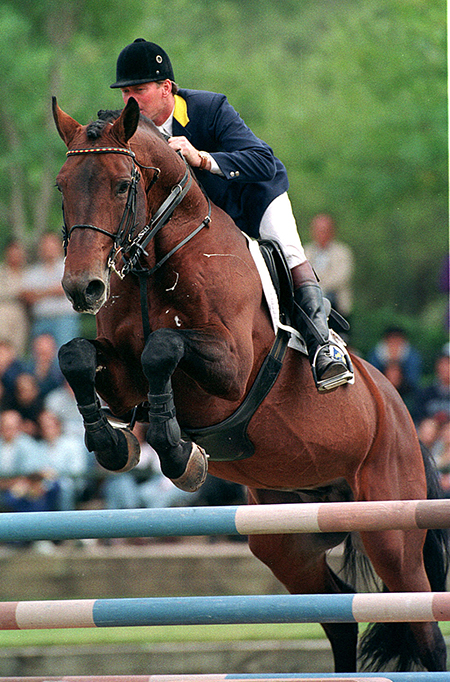
Calvaro and Jos Lansink
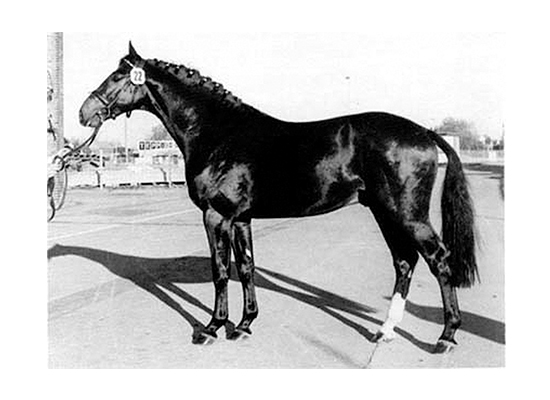
Caletto II
Caletto II has been most influential through his son, Caretino (Metellus) who competed internationally with Bo Kristoffersen. The stallion Casall (Caretino / Lavall I) who after a brilliant career in showjumping at the highest level is proving a very successful sire, is the most prominent carrier of Caletto II’s legacy.
Casall at the 2012 London Olympics
Story continues below the advertisement
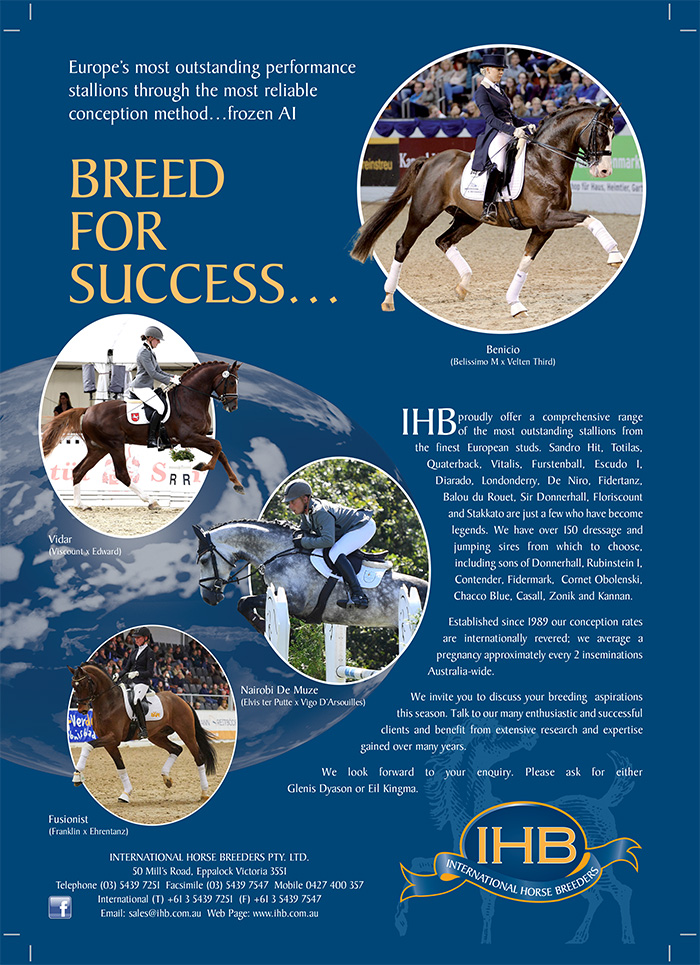
Tabelle
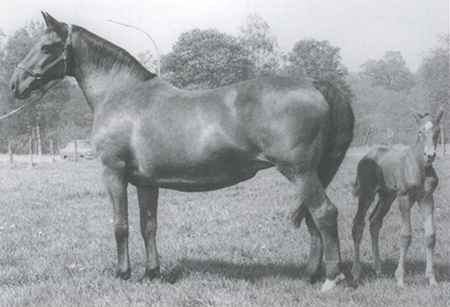
Tabelle by Heißsporn out of a Lorentin mare, is most famous for her five sons by Cor de la Bryère, the Calypso brothers. Here is what The Holsteiner Horse has to say about the mare: “Tabelle was a large, heavy-built, true-to-type Holsteiner dam of first-class descent. The pedigree shows that she was strongly inbred to the top stallion, Tobias, who was Achill’s best son, as well as carrying the blood of Ethelbert via Lorentin/Loretto, who is a guarantee for excellent movement and rideability. Tabelle’s line, 6582 gained world wide fame through the dressage horse, Granat, whose dam is a full-sister to Tabelle… Tabelle’s granddaughter, Tibris by Cor de la Bryère produced the licensed stallion, Askari by Acord II. All the Calypso brothers were different in colour, size, conformation and build. The oldest brothers Calypso I and II achieved the greatest reputations.”
All the Calypso brothers were by the French import, Cor de la Bryère. At the end of the 1960’s the Holsteiner horse had been greatly refined thanks to the introduction of Thoroughbred blood. Of the 37 stallions at stud in Holstein in 1970, 14 were Thoroughbreds and 15 the grandsons of a Thoroughbred.
Again we turn to The Holsteiner Horse: “The Thoroughbred stallions did indeed improve the action potential in canter, the type, leanness and certain riding qualities but this was also sometimes coupled with a loss of leg technique and jumping style.”
The hunt was on for new blood and the Verband looked to Normandy, where many of the successful stallions shared the same genetic heritage at the stallions in Holstein: Ladykiller xx, Cottage Son xx and Marlon xx. The Holstein Commission was given the opportunity to lease the Furioso son, Urioso but while they were doing that deal, Maas J Hell was taken with one of the younger colts, Cor de la Bryère, although the Holstein breeders were initially unimpressed since he was still very foal-like on his arrival.
Cor de la Bryère
Urioso disappears, and ‘Corde’ becomes the single most influential jumping stallion of our times. After he easily won his performance test, Cor de la Bryère found just the mares he needed. Indeed the French breeding authority Bernard le Courtois suggested that it was only the trip to the north that made him a sire:
“Some stallions cross very well in a particular situation. For example, Cor de la Bryère. He was exceptional in the 70s in Holstein because he was a horse that was very quick with the front legs. He did not have the power on the back side, but he was a very electric horse, with the blood of the Thoroughbred, Rantzau, and mixed with the heavy Holsteiner mares, he was fantastic. But when we tried to breed Cor de la Bryère with the French mares, we had rabbits. Cor de la Bryère needed a very strong mare, and we didn’t have this kind of mare in France.”
In The Holsteiner Horse the authors are very complimentary of Calypso I: “A significant stud stallion with a great outline. Plenty of expression, a good neck, nice shoulders and withers, rather straight croup; long-legged with a certain spring of ribs; strong, correct legs with high-set hocks; well pronounced joints; excellent movement. Sturdy despite his aristocracy.”
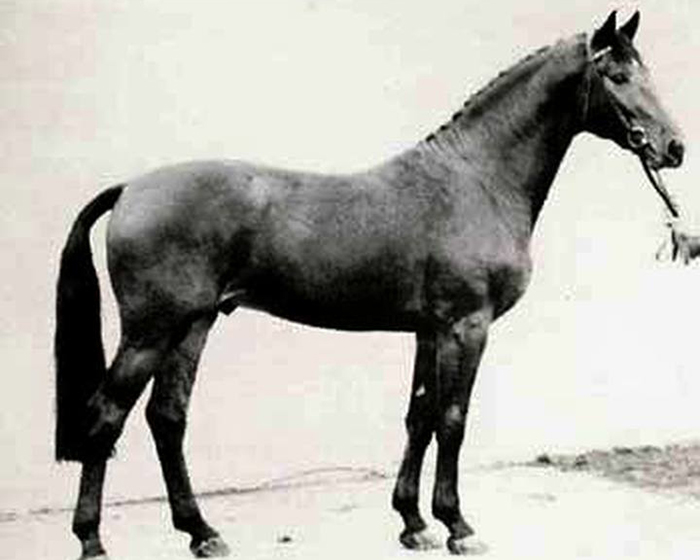
Calypso I
And yet, they also note that the Calypso I sire line has died out in Holstein – and really his only star was a dressage horse, Alexandra Simons-de Ridder’s wonderful Chacomo, a European and Olympic gold medallist.
Chacomo at the 2000 Olympics with Alexandra Simons-De Ridder
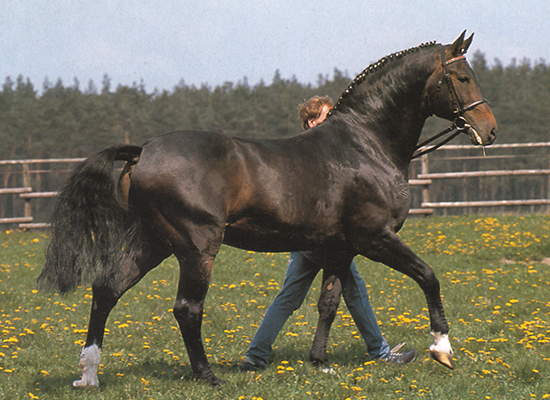
Calypso II
On the other hand, his brother, Calypso II has had enormous influence on the development of the horses of the Hanoverian Verband but was also a significant force in Holstein through his mega-star stallion son, Contender.
Once again, let the Holstein breeding experts, Thomas Nissen, Gabriele Pochhammer, Donate von Preußen and Joachim Tietz celebrate Calypso II’s qualities: “A true-to-type stallion with plenty of character and amazing drive. A rather coarse head with a wide neck and strong jowls, good line in the shoulder, withers and loins… The stallion could have been more elegant. Great own performances in the jumping sport. Calypso II excelled though his exceptional, inborn rideability, which he consistently passed on to his offspring.”
Indeed, Calypso II was one of the first combine a stud career with a competition career, although he was withdrawn from breeding in 1981 after three seasons to take up a full-time career as a showjumper with Michael Rüping. In 1982 he returned to breeding and in 1984 sired his best son, Contender.
Again to quote from The Holsteiner Horse: “The stud career of Calypso, who was not easy to find an appropriate mate for due to his size (175 cm!) can be described as variable. At times he was very popular among the Holsteiner breeders and at others the demand was not so high.”
So like his sire Cor de la Bryère, Calypso II found fame and a home when put to a very different mare population – the Hanoverians.
In 1987, he was leased to the Celle Stud for three years, although Dr Bade had his work cut out to persuade the Hanoverian mare owners to use him: “I think he was the first Holstein stallion we brought into the Hanoverian studbook, now Calypso features on many mother lines, and they all tend to have very good jumping ability and good riding ability. Calypso II is a big very strong and heavy horse – we knew him from the performance test and when he was offered to me from the Holstein Association when he was about ten years old, I said ‘yes’. But when I offered him to the breeders, and I saw their faces! Such legs and such hooves!! I think 900 kilos weight. They said, ‘oh well if you think it is a good idea, we will try with him’. And they had very big success.”
Valeska IV
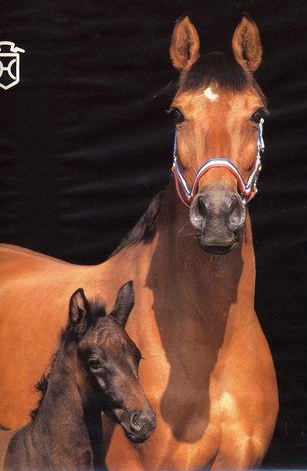
Valeska is by Fernando (Farnese / Consul) who was born in 1976, who stood in Holstein from 1979 to 1986 aside from the year spent in Belgium in 1984. Fernando was just a touch over 17 hands, and Dietrich Rossow noted in the Stallion Book of the Holsteiner Warmblood Breed:
“Almost too big a sire with good stallion expression. Short coupled and supple nevertheless. Heavy neck. Well muscled forequarter, not so behind. Slightly calf kneed. Sickle hocked. Very good mover in trot and canter. Barely adequate walk. Good under saddle. Scope over fences.”
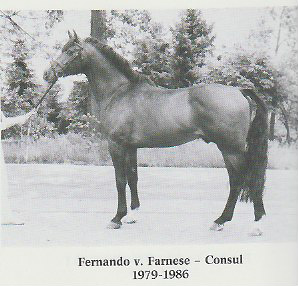
“Produce: Notable broodmare sire. Offspring are solid horses with jumping ability and good movers. Could show a little more expression and be a little more lively. Some fabulous State Premium mares. Must have mares with a lot of Thoroughbred blood. 2 approved sons, 57 approved daughters.”
Valeska had blood enough, 46.88% to be precise, as her dam Option was by the half-blood, Lord (Ladykiller xx). Option’s grand-dam, Ruth contributed more ‘blood’ since she was by Harras by the Anglo Arab, Harrar.
Valeska was one of the important mares in the exceptional broodmare band of Hobe Bernhard.
Hobe and Valeska
Breeding on the Bernhard farm had started with heavy horses, but after the Second World War, the attention turned to horses for the growing market of jumping competitors, but always as part of the overall farm economy.
“I use stallions that produce horses that if I don’t sell the offspring as foals, they will make nice rideable showjumpers.”
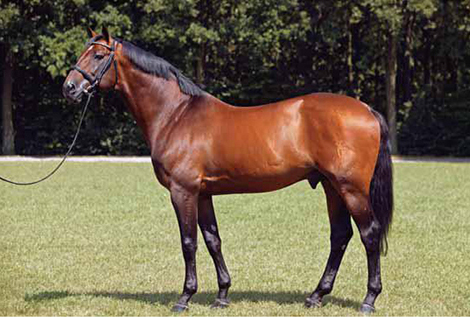
Coriano
The most famous horse he has produced is Coriano. The stallion is by Corrado out of Hobe’s Lord / Ramiro mare, Option, and he stood at the Holsteiner Verband Stallion Barn at Elmshorn. In 1993 Coriano passed his stallion performance test in Marbach with scores of 10.0 for character, performance ability and aptitude for jumping. He was an international star with Denmark’s Bo Kristoffersen and then won the 2003 Belgian Junior Championship with the Belgian Judy Ann Melchior before being ridden by her with success on the international circuit.
Hobe’s Lord mare, Option, one of the jewels of his farm…
Valeska IV is the ‘mother’ of the stud, having produced a staggering total of 18 foals in her 24 years – including three licensed stallions, Corofino I & II and the licensing winner, Camiros. The mare herself is a half sister to the very famous, Coriano. Another stallion son, Corofino 16, re-christened Damascus 1st, jumped 1.50 with Roger Yves-Bost.
Hobe and Valeska
Valeska’s pedigree is sort of a mini-history of Holstein jumping breeding. She is by Fernando (by Farnese out of a Consul mare) out of Option (by Lord out of a Ramiro mare).
Aside from her stallion sons, Valeska has been a very good producer of brood mares. Her daughter, H-Corofina (Corrado) is the dam of the 1.50 jumper, Questro (Quidam de Revel) and the licensed stallions, Counter (Calido) approved for Holstein, and Quantor (Quidam de Revel) approved AES and SF.
Another daughter, La Corofina (Corrado) foaled ABC Panama (Caribik) who jumps 1.50, Barbou du Ruet (Baloubet du Rouet) 1.55 and Zara 104 (Baloubet du Rouet) who competes at 1.60 level.
Folia
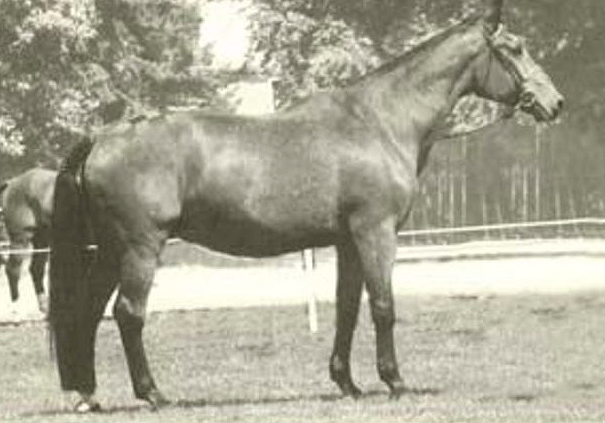
In 1960, a wayward mare, Rappel was saved from the knackery by Rheder Thormählen, a breeder from a family who had lived on the Kollmaran marsh for 500 years, where they had been involved in the breeding, riding and selling of horses throughout that time. Rappel, who was by Heinzelmann, had made herself unpopular by jumping out of paddocks, and was still jumping at the age of 23 when she won an elementary showjumping class!
Herr Thormählen did not know it at the time but Rappel had an earlier foal, by the influential Arabian bred, Ramzes, who, as Romanus, had won the Grand Prix of Rome with Hans Günter Winkler.
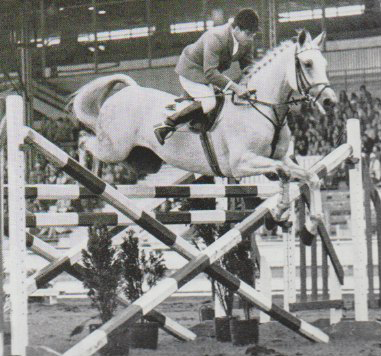
Romanus and H G Winkler take silver at the 1962 Europeans
Ten years later, Rappel presented Thormählen with another Ramzes foal, this time a filly, Vase – who went on to be champion mare of Holstein. Vase’s full-brother, Roman topped the German showjumping standings for two years running with Hans-Gunter Winkler. Vase’s daughter, Folia, by Maximus (himself an Advanced showjumper), foaled five stallions: Latus I and II (both by Landgraf), and then Capitol. Capital was by Capitano who is by Corporal out of Retina (also by Ramzes). Retina won the Hamburg Derby with Fritz Thiedemann in the saddle.
Capitano, sire of Capitol but who was his sire?
The query as to Capitol’s antecedents has been raised in an article by Gabrielle Mohmann-Pochhammer (the editor of the German magazine, St Georg) in an article in Horse International (No 5, 2001).
Retina, the dam of Capitano
According to Ms Pochhammer while it is recorded that Capitol’s sire Capitano, is out of Retina, and by Corporal, this may not be the case: “On paper the bay Corporal was the sire of Capitano, but even when the stallion was still alive, doubts about the pedigree kept surfacing. This was because Capitano was a grey who dominantly passed on his colour, and is said to have produced only a few chestnut foals. But homozygous greys usually have two greys as parents. At the time in question, a young grey stallion, Vase’s son, Grand Vicar, a brother of Folia, had been frolicking with Retina in the paddock. If the suspicions, which were never substantiated by appropriate genetic tests, are true, then Capitol would be the product of intensive in-breeding, and Ramzes’ blood would be in his genes via Retina and Vase, and a third time via his grand-sire. But we will never be sure about that…”
According to Harm Thormälen, whose family bred Capitol:
“The Capitol horses have scope – scope and easy to handle. Amateurs can ride the Capitol horses. Sometimes they are not ‘blood’ enough, they need blood. In his last years Capitol was only allowed to breed to mares with Thoroughbred blood. The mare sire had to be Thoroughbred, or otherwise Cor de la Bryère – so Capitol got very good mares. It was top management by the Holsteiner Verband, with very good results in the sport. The children of Capitol have won the most money in the sport of any stallion in the world.”
They have been breeding horses at the farm of the family Thormählen for 440 years. His father, Rheder Thormählen started breeding jumping horses after the Second World War, and Harm took over the yard in 1973. This has been the birthplace of many famous horses such as Capitol and Cera, and Harm Thormählen is regarded as one of the smartest jumping breeders in the world today.
 “Two years ago we had a party – it was 440 years that this farm was in the family – always with horses,” Harm tells me. “Here they used to work with horses always. They had to work very hard, the ground here is very special. If you try to plough one hour too late, then the ground is hard like cement. The horses had to work very hard.”
“Two years ago we had a party – it was 440 years that this farm was in the family – always with horses,” Harm tells me. “Here they used to work with horses always. They had to work very hard, the ground here is very special. If you try to plough one hour too late, then the ground is hard like cement. The horses had to work very hard.”
“In 1950 came the first tractor, and the mares went to the butcher – they no longer needed horses! But my father, Rheder Thormählen was interested in horses – after the war he was an international showjumper, and he dealt a lot of horses, this was his hobby. I don’t remember it myself, but Alwyn Schockemöhle told me, my father was one of the biggest dealers in Europe. His hobby was to buy international showjumpers, famous mares who were Grand Prix showjumpers, and 40/50 years later, comes the result from those famous mares. Even at that time, those mares were very expensive. We only breed for jumping on this farm.”
Folia produced many stallion sons including the three Capitols (though only the first was really influential) and the Latus brothers (by Landgraf). Her daughter U-Capitol (Capitol’s full sister) had six stallion sons, the most successful of which was the 1.55 competitor, Quite Capitol by Quidam de Revel.
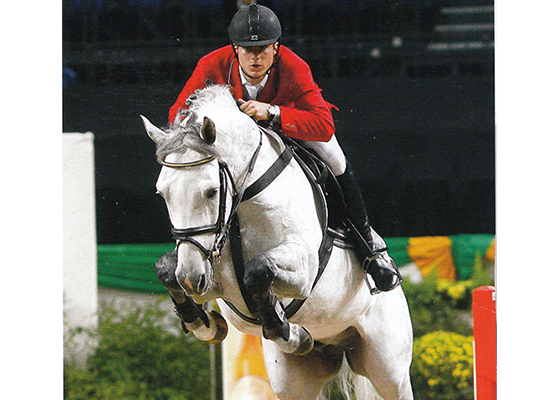
Quite Capitol
U-Capitola is also the dam of Birte II, the dam of Quite Easy I and II by Quidam de Revel. Another stallion son of Birte II is Casir Ask, a 1.60 jumper with Lars Pedersen. Birte II’s daughter, L-Texas (Tin Rocco) produced two 1.50 competitors, Cameron de Hus (Contendro I) and Uxelhus (Lamm de Fetan). Another Birte daughter, Pretty Easy (Quidam de Revel) is the dam of For Europe (For Pleasure), 1.45; Balotan (Baloubet de Rouet), 1.50 and Oak Groves Celebrity (Cassini II) who jumped 1.60.
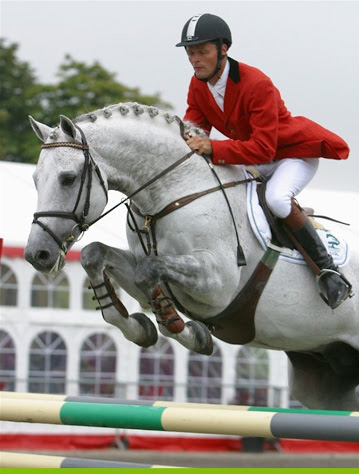
Casir Ask
And yes, there is more still to come, when we talk to Egbert Schep and Anaud Evain…




